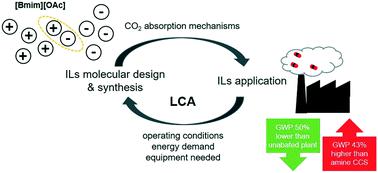当前位置:
X-MOL 学术
›
React. Chem. Eng.
›
论文详情
Our official English website, www.x-mol.net, welcomes your feedback! (Note: you will need to create a separate account there.)
A life cycle approach to solvent design: challenges and opportunities for ionic liquids – application to CO2 capture
Reaction Chemistry & Engineering ( IF 3.9 ) Pub Date : 2020-12-10 , DOI: 10.1039/d0re00409j Rosa M. Cuéllar-Franca 1, 2, 3, 4, 5 , Pelayo García-Gutiérrez 1, 2, 3, 4, 5 , Jason P. Hallett 5, 6, 7, 8 , Niall Mac Dowell 5, 7, 8, 9, 10
Reaction Chemistry & Engineering ( IF 3.9 ) Pub Date : 2020-12-10 , DOI: 10.1039/d0re00409j Rosa M. Cuéllar-Franca 1, 2, 3, 4, 5 , Pelayo García-Gutiérrez 1, 2, 3, 4, 5 , Jason P. Hallett 5, 6, 7, 8 , Niall Mac Dowell 5, 7, 8, 9, 10
Affiliation

|
CO2 capture and storage is widely anticipated to play a key role in combatting climate change, however the solvents proposed for use have embedded environmental concerns. This has led to efforts to develop so-called “green solvents” such as ionic liquids. However, this “green” assertion does not account for the production and disposal phases of solvent life, nor take into account other factors, apart from their “task”, that will have an impact on their overall environmental sustainability. The absence of a “cradle-to-grave” evaluation introduces a risk burden shift, thus, this paper presents a life cycle approach to identify the main hotspots across the application of an ionic liquid to a post-combustion CO2 capture process. With a focus on the solvent, molecular-level weaknesses in the design and synthesis, and potential opportunities for improvement are identified. We contrast the use of 1-butyl-3-methylimidazolium acetate or [Bmim][OAc] with a 30 wt% MEA solvent, using an unabated power plant as a baseline. Using MWhe as the functional unit, we observed that the IL-based process reduces the global warming potential of electricity generation by 50% relative to the unabated plant, however this outcome is 43% higher than the conventional amine process. In fact, the so-called “green solvent” actually represented the worst option when considering the full spectrum of environmental impacts. The general incorporation of this approach in solvent development will be vital to ensure genuine progress in tackling climate change, and not simply shifting the burden to other areas.
中文翻译:

溶剂设计的生命周期方法:离子液体的挑战和机遇–应用于二氧化碳捕集
广泛预期CO 2的捕获和储存将在应对气候变化中发挥关键作用,但是,建议使用的溶剂具有潜在的环境问题。这导致人们努力开发所谓的“绿色溶剂”,例如离子液体。但是,这种“绿色”主张没有考虑溶剂寿命的生产和处置阶段,也没有考虑除了其“任务”之外的其他因素,这些因素将对其整体环境的可持续性产生影响。缺少“从摇篮到坟墓”的评估会带来风险负担的转移,因此,本文提出了一种生命周期方法,可在将离子液体应用于燃烧后CO 2的过程中确定主要热点捕获过程。着眼于溶剂,确定了设计和合成中的分子级弱点以及潜在的改进机会。我们对比了使用30重量%MEA溶剂与乙酸1-丁基-3-甲基咪唑鎓乙酸盐或[Bmim] [OAc],以未减弱的电厂为基准。使用兆瓦时Ë作为功能单元,我们观察到基于IL的过程相对于未减弱的工厂将全球发电变暖潜能降低了50%,但是这一结果比常规的胺过程高43%。实际上,考虑到整个环境影响时,所谓的“绿色溶剂”实际上是最糟糕的选择。在溶剂开发中普遍采用这种方法,对于确保在应对气候变化方面取得真正进展至关重要,而不仅仅是将负担转移到其他领域。
更新日期:2020-12-22
中文翻译:

溶剂设计的生命周期方法:离子液体的挑战和机遇–应用于二氧化碳捕集
广泛预期CO 2的捕获和储存将在应对气候变化中发挥关键作用,但是,建议使用的溶剂具有潜在的环境问题。这导致人们努力开发所谓的“绿色溶剂”,例如离子液体。但是,这种“绿色”主张没有考虑溶剂寿命的生产和处置阶段,也没有考虑除了其“任务”之外的其他因素,这些因素将对其整体环境的可持续性产生影响。缺少“从摇篮到坟墓”的评估会带来风险负担的转移,因此,本文提出了一种生命周期方法,可在将离子液体应用于燃烧后CO 2的过程中确定主要热点捕获过程。着眼于溶剂,确定了设计和合成中的分子级弱点以及潜在的改进机会。我们对比了使用30重量%MEA溶剂与乙酸1-丁基-3-甲基咪唑鎓乙酸盐或[Bmim] [OAc],以未减弱的电厂为基准。使用兆瓦时Ë作为功能单元,我们观察到基于IL的过程相对于未减弱的工厂将全球发电变暖潜能降低了50%,但是这一结果比常规的胺过程高43%。实际上,考虑到整个环境影响时,所谓的“绿色溶剂”实际上是最糟糕的选择。在溶剂开发中普遍采用这种方法,对于确保在应对气候变化方面取得真正进展至关重要,而不仅仅是将负担转移到其他领域。



























 京公网安备 11010802027423号
京公网安备 11010802027423号